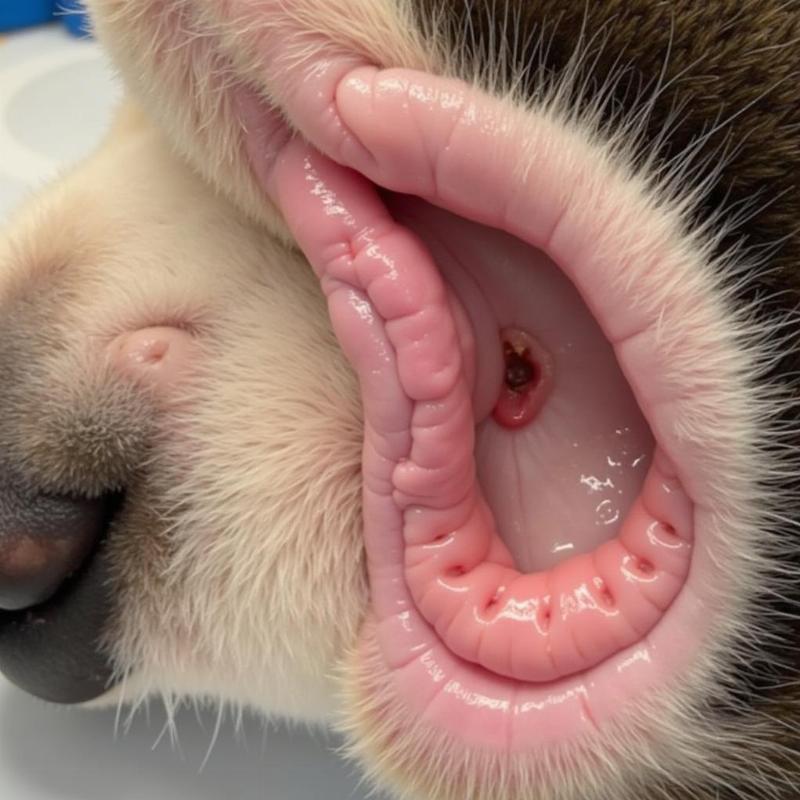Episioplasty and vulvoplasty are surgical procedures performed on female dogs to correct anatomical abnormalities of the vulva and surrounding tissues. These procedures can significantly improve a dog’s quality of life by addressing issues that can cause discomfort, infection, and even difficulty urinating or defecating. Understanding the “episioplasty vulvoplasty dog before and after” aspects is crucial for pet owners considering these procedures.
 Dog Before Episioplasty Vulvoplasty
Dog Before Episioplasty Vulvoplasty
Recessed vulva, a common reason for these surgeries, can trap urine and feces, leading to skin irritation, infections, and an unpleasant odor. Vulvoplasty corrects this by reconstructing the vulva to a more normal anatomical position. Episioplasty, often performed in conjunction with vulvoplasty, involves enlarging the vaginal opening, usually to address vaginal stenosis (narrowing). This is particularly relevant for breeding dogs, as stenosis can interfere with natural mating and birthing.
Understanding Episioplasty
Episioplasty focuses on the vaginal opening. The procedure involves making an incision to widen the opening, allowing for easier passage of urine, feces, and, if applicable, puppies during birth. This procedure can prevent recurring infections and improve overall hygiene.
Understanding Vulvoplasty
Vulvoplasty addresses the external anatomy of the vulva. This procedure aims to reshape and reposition the vulva to its normal anatomical position, preventing the trapping of urine and feces. This can greatly improve a dog’s comfort and hygiene.
Episioplasty Vulvoplasty Dog Before and After: What to Expect
Before the surgery, your veterinarian will conduct a thorough examination and may recommend blood work to ensure your dog is healthy enough for anesthesia. After the surgery, your dog will need to wear an Elizabethan collar (e-cone) to prevent licking and chewing at the incision site. Pain medication and antibiotics will likely be prescribed.
The recovery period typically lasts a few weeks. During this time, it’s crucial to monitor the incision site for any signs of infection, such as redness, swelling, or discharge. Regular check-ups with your veterinarian are essential to ensure proper healing. The “after” picture often shows a significantly improved vulvar anatomy, leading to better hygiene and comfort for the dog. “The positive impact of these procedures on a dog’s well-being is often remarkable,” says Dr. Emily Carter, DVM, a leading veterinary surgeon in New York. “Owners frequently report a significant improvement in their dog’s comfort and hygiene after recovery.”
Long-Term Benefits
Long-term benefits of these procedures often include reduced risk of urinary tract infections, improved hygiene, and increased comfort. For breeding dogs, successful episioplasty can facilitate natural mating and birthing. “Addressing these anatomical issues early can prevent significant discomfort and potential complications down the line,” adds Dr. Carter.
Conclusion
Episioplasty and vulvoplasty are valuable surgical options for female dogs with anatomical abnormalities of the vulva. Understanding the “episioplasty vulvoplasty dog before and after” aspects can help owners make informed decisions about their dog’s care. These procedures can greatly improve a dog’s quality of life, leading to a happier, healthier companion.
FAQ
- How long does the recovery period typically last? The recovery period is typically a few weeks.
- What are the signs of infection after surgery? Redness, swelling, and discharge are potential signs of infection.
- Is an e-collar necessary after surgery? Yes, an e-collar is crucial to prevent licking and chewing at the incision site.
- What are the long-term benefits of these procedures? Long-term benefits include reduced risk of infections and increased comfort.
- Are these procedures suitable for all female dogs? Your veterinarian will determine if these procedures are appropriate for your dog’s specific condition.
- What kind of pre-operative preparations are needed? Your vet will likely recommend a physical exam and blood work.
- How can I ensure proper healing after surgery? Follow your veterinarian’s instructions, administer medications as prescribed, and monitor the incision site.
Beautdogs.us is your trusted resource for comprehensive dog care information, breed-specific advice, and product reviews. We cater to both novice and seasoned dog owners, empowering you to provide the best possible care for your furry companions. For expert guidance on dog health and wellness, visit Beautdogs.us or contact us at [email protected] or +1 501-555-7529.